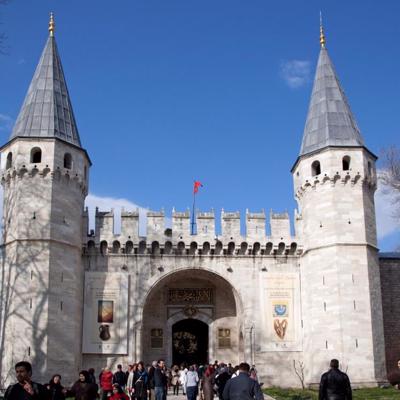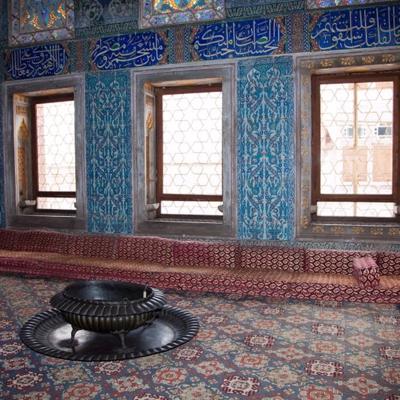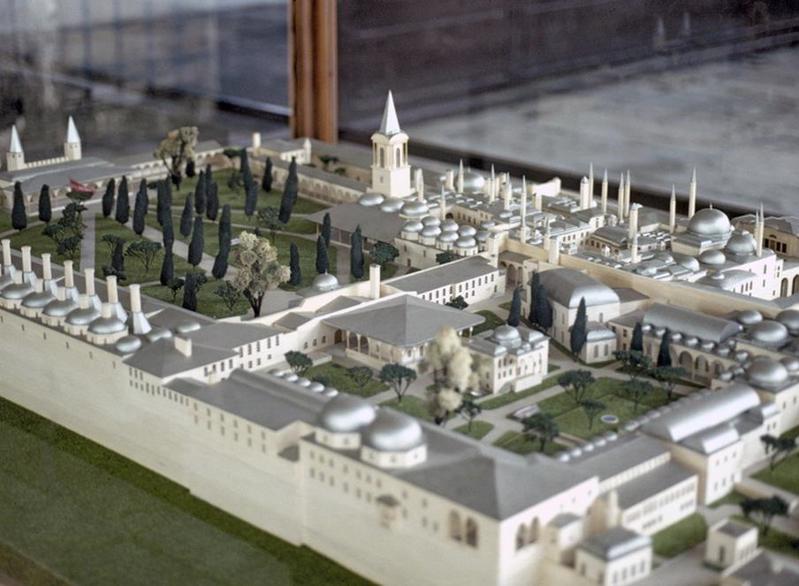A ticket to Ottomans Era
Topkapi Palace was built after the conquest of Constantinople during the reign of Sultan Mehmet II. Since 1924 Topkapi Palace is used as a museum.1 The appealing atmosphere attracts the tourists with the old manuscripts, architecture, and plain decorations from Ottomans, including the relics from Prophet Muhammed. "The palace complex comprises four main courtyards and smaller buildings. The gate is richly decorated on both sides and in the upper part with religious inscriptions and monograms of sultans."2
During the Ottomans era, the palace had multifunction such as accommodation, "administrative, military, educational, and arts activities." 3 Each courtyard has different roles. "The first courtyard (sometimes called the Outer Courtyard) is the largest and only public courtyard."4 The second courtyard is Divan Square, which is used for administration.5 The third courtyard is "Innermost Courtyard, which housed the private residence of the sultan and the inner palace school."6 The fourth courtyard contains "terraced gardens and pavilions".7 There is also the Harem section in which female members of the palace live. Girls are educated in the harem and develop their skills.
The palace witnessed many Sultans and innovations in their
nbo12345nbo
5 chapters
16 Oct 2020
Topkapi Palace
May 13, 2017
|
Istanbul
Topkapi Palace was built after the conquest of Constantinople during the reign of Sultan Mehmet II. Since 1924 Topkapi Palace is used as a museum.1 The appealing atmosphere attracts the tourists with the old manuscripts, architecture, and plain decorations from Ottomans, including the relics from Prophet Muhammed. "The palace complex comprises four main courtyards and smaller buildings. The gate is richly decorated on both sides and in the upper part with religious inscriptions and monograms of sultans."2
During the Ottomans era, the palace had multifunction such as accommodation, "administrative, military, educational, and arts activities." 3 Each courtyard has different roles. "The first courtyard (sometimes called the Outer Courtyard) is the largest and only public courtyard."4 The second courtyard is Divan Square, which is used for administration.5 The third courtyard is "Innermost Courtyard, which housed the private residence of the sultan and the inner palace school."6 The fourth courtyard contains "terraced gardens and pavilions".7 There is also the Harem section in which female members of the palace live. Girls are educated in the harem and develop their skills.
The palace witnessed many Sultans and innovations in their

reigns throughout history. Thus the museum contains diverse sources such as "Ottoman textiles and silk royal robes; jewel-encrusted ceremonial objects; intricately designed wool and silk carpets from imperial looms; finely crafted armor and weaponry; Chinese porcelains; musical instruments; illuminated religious and literary manuscripts; and bejeweled domestic objects."8
There are also many gifts from other countries' representatives to the Ottoman sultans."9 Walking from one section to one section, the chambers' plain design, including vivid miniatures and shiny jewels, makes you feel like traveling in a time machine. The enrich materials give an idea about the economy of the era and demanded goods. Topkapi Palace still is an attractive site due to its long-standing background.
Notes
1. Alauddin, Davud Aga, Mimar Sinan, Sarkis Balyan, (Topkapi Palace: Gate of Salutation), 1459-1465, Topkapi Palace, Istanbul, TR. https://library-artstor-org.eznvcc.vccs.edu:2443/asset/ASITESPHOTOIG_10313841747.


IG_10313841747.
2. Ibid
3. Mark Epstein, "Treasures of the Topkapi Palace." USA Today, 05, 2000, 36-45,p. 36, https://eznvcc.vccs.edu:2443/login?url=https://www-proquest-com.eznvcc.vccs.edu:2443/docview/214600802?accountid=12902.
4-7. Alicja Zelazko, “Topkapi Palace Museum,” Encyclopædia Britannica, March 2020, https://www.britannica.com/topic/Topkapi-Palace-Museum.
8. Mark Epstein, "Treasures of the Topkapi Palace." USA Today, 05, 2000, 36-45,p. 37, https://eznvcc.vccs.edu:2443/login?url=https://www-proquest-com.eznvcc.vccs.edu:2443/docview/214600802?accountid=12902.
9. Mark Epstein, "Treasures of the Topkapi Palace." USA Today, 05, 2000, 36-45,p. 45, https://eznvcc.vccs.edu:2443/login?url=https://www-proquest-com.eznvcc.vccs.edu:2443/docview/214600802?accountid=12902.
Bibliography
1. Epstein, Mark. "Treasures of the Topkapi Palace." USA Today, 05, 2000, 36-45, https://eznvcc.vccs.edu:2443/login?url=https://www-proquest-com.eznvcc.vccs.edu:2443/docview/214600802?accountid=12902.
2. Initially built by Sultan Mehmed II; architects involved in the design of the structure throughout the years are Alauddin, Davud Aga, Mimar Sinan, Sarkis Balyan; Gate of Salutation was most likely built by Sultan Suleiman I. Built circa 1459-1465; renovated and repaired many times, especially circa 1509 after an earthquake damage and circa 1665 after a fire damage; circa 1856 it ceased to serve as a palace; since 1924 is serves as a museum; Gate of Salutation was erected circ. Topkapi Palace, Gate of Salutation / Bab-us Selam / The Middle Gate. https://library-artstor-org.eznvcc.vccs.edu:2443/asset/ASITESPHOTOIG_10313841747.
3. Palace ordered by Sultan Mehmed II. palace 1460s-70s, and later; model c. 1985. Model of the Topkapi Palace. Architecture and City Planning, Architecture. https://library-artstor-org.eznvcc.vccs.edu:2443/asset/ISLAMIC_DB_10310193498.
4.Topkapi Palace Initially built by Sultan Mehmed II; architects involved in the design of the structure throughout the years are Alauddin, Davud Aga, Mimar Sinan, Sarkis Balyan; Harem designed mostly by Architect Mimar Sinan; renovated by Sultans Mahmud I. Topkapi Palace built circa 1459-1465; renovated and repaired many times, especially circa 1509 after an earthquake damage and circa 1665 after a fire damage; circa 1856 it ceased to serve as a palace; since 1924 is serves as a museum; Harem built in the 1. Topkapi Palace, Harem, Chamber of the Princes. https://library-artstor-org.eznvcc.vccs.edu:2443/asset/ASITESPHOTOIG_10313841433.
5. Zelazko, Alicja. “Topkapi Palace Museum.” Encyclopædia Britannica, March 2020. https://www.britannica.com/topic/Topkapi-Palace-Museum.
Share your travel adventures like this!
Create your own travel blog in one step
Share with friends and family to follow your journey
Easy set up, no technical knowledge needed and unlimited storage!